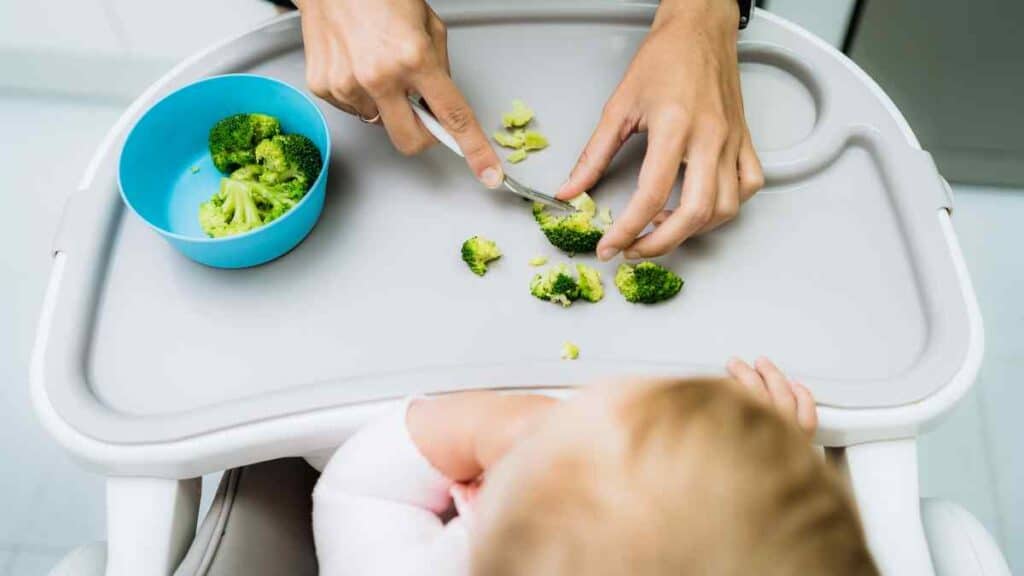Introducing solid foods to your baby is an exciting milestone in their growth and development. It begins a new chapter in their lives, filled with diverse flavors and textures. As parents, you want to ensure you provide your little one with the best possible start to their lifelong healthy eating journey.
Providing your baby with a balanced diet is crucial to ensure they receive all the essential nutrients they need for healthy growth and development. As you embark on this journey, you’ll discover the best first foods to introduce, learn about allergenic foods and their safe introduction, and understand the importance of gradually increasing food consistency.
So, let’s get started on this exciting adventure and set the stage for a lifetime of healthy eating habits for your little one.

Importance of Introducing First Foods for Baby
The journey of introducing solid foods to your baby is an essential and exciting milestone in their growth and development. It marks the transition from a milk-based diet to one that includes a variety of tastes, textures, and nutrients. In this column, we will explore the importance of introducing the first foods for your baby and guide how to create a positive experience for your little one.
Nutritional benefits
As babies grow, their nutritional needs change. Around six months of age, breast milk or formula alone may not provide all the nutrients required for healthy growth and development. Introducing solid foods like sweet potato, rice, and cooked greens can help ensure your baby receives essential nutrients, including iron, healthy fats, and vitamins.
Development of motor skills
Offering your baby solid foods, especially using the baby-led weaning style, encourages your baby to explore new textures and practice their fine motor skills. Self-feeding with soft finger foods can help your baby develop hand-eye coordination and chewing and swallowing abilities.
Palate development
Introducing a variety of flavors and textures to your baby’s diet can help them develop a diverse palate and foster a lifelong appreciation for a wide range of foods. Begin by offering simple, mashed foods, and gradually progress to more complex flavors and textures.
Allergy prevention
Early introduction of certain foods, like peanuts, can help prevent food allergies, especially if there’s a family history of allergies. However, always consult your pediatrician before introducing potentially allergenic foods to your baby.
Establishing healthy eating habits
Introducing a variety of nutritious solid foods can set the stage for lifelong healthy eating habits. Offering fresh, whole foods instead of processed, sugary options can help your baby develop a preference for healthier choices.
Supporting growth and development
Starting solid foods at the appropriate age can support your baby’s growth and development. While young babies rely on breast milk or formula, the introduction of solid foods provides essential nutrients and energy needed as they grow and become more active.
At What Age Should I Start Baby-led Weaning?

Like many child-rearing adults, you’re always seeking the best solid food for your baby, especially regarding their nutrition. One popular approach to introducing solid foods is baby-led weaning (BLW). But at what age should you start this method? Let’s explore the appropriate age for baby-led weaning and the crucial factors to consider when introducing new foods to your little one.
Baby-led weaning typically begins around six months of age, when your baby can sit up independently and has developed the ability to grasp objects. This is the time when most babies are ready to explore finger foods and experience a new world of tastes and textures beyond breast milk or formula.
To ensure a smooth transition from a milk-based diet to solid foods, start with simple and easily digestible first foods for your baby. Baby cereal, such as rice cereal, is an excellent choice as it can be easily mixed with breast milk or formula. Soft fruits and vegetables like sweet potato, avocado, and banana are also ideal options for your baby’s first foods.
Introducing a wide variety of baby food is essential to help your little one develop a diverse palate. Start with single-ingredient homemade baby food or store-bought purees before progressing to more complex recipes. While offering a range of flavors and textures is important, be cautious when introducing raw vegetables and harder foods like hot dogs, as these can pose a choking risk.
Food allergies are a significant concern for many parents. Introduce potentially allergenic foods, such as eggs, cow’s milk, or peanuts, one at a time, and wait for a few days before adding another new food. This allows you to monitor your baby for any signs of a food allergy and helps to identify the specific allergen if a reaction occurs.
Balancing Solid Foods with Breast Milk or Formula

As your baby begins this exciting baby food journey, it’s crucial to balance solid foods with breast milk or formula to ensure they receive adequate nutrition. This column will provide helpful tips for striking the right balance as you introduce solid foods to your baby’s diet.
Gradually introduce solids
As you offer solid baby foods, start with small amounts and gradually increase the quantity over time. Foods like mashed sweet potatoes, rice, and cooked green beans make excellent first options. Remember that it may take time for your baby to adjust to these new tastes and textures.
Maintain breast milk or formula as the primary source of nutrition
Breast milk or formula should continue to provide most of their nutrition and calories until your baby’s first birthday. Solid foods are meant to complement, not replace, these essential sources of nourishment.
Be mindful of portion sizes
Offer finger foods and other baby-friendly options in appropriate portions, allowing your baby to explore and enjoy them at their own pace. Foods like mashed potatoes, hard-boiled egg pieces, and soft-cooked vegetables make great choices.
Schedule nursing or bottle-feeding around solid foods
Nurse or offer formula to your baby before introducing solid foods, ensuring they are not overly hungry when trying new foods. This will help maintain a healthy balance between breast milk, formula, and solid foods in your baby’s diet.
Monitor your baby’s growth and development
Regular check-ups with your pediatrician will help ensure your baby is growing and developing appropriately. Discuss any concerns regarding your baby’s nutrition or the introduction of solid foods with your healthcare professional.
Offer a variety of nutritious foods
As your baby becomes more comfortable with solid foods, introduce a diverse range of healthy options, such as fruits, vegetables, lean proteins, and whole grains. This variety will provide essential nutrients like healthy fats, vitamins, and minerals while helping your baby develop a diverse palate.
Be patient and flexible
Every baby is unique, and their preferences and needs may change. Be willing to adjust your approach as needed, and remain patient as your baby explores new foods and develops their eating habits.
Best First Foods for Baby-Led Weaning

Our previous article explored the ideal age at which parents should start baby-led weaning, which is around six months when babies are developmentally ready to explore new tastes and textures. Now let’s delve into the best first foods for your baby to ensure a smooth and successful transition to solid foods while keeping potential food allergies in mind.
Introducing solid foods to your baby can be an exciting time for both parents and infants. Providing a range of nutritious, healthy foods rich in important nutrients such as iron, vitamin C, and healthy fats is essential. Here are some suggestions for baby’s first foods:
- Sweet potato: Soft, easy to mash, and packed with nutrients, sweet potatoes make an excellent option for introducing solid foods to your baby. Simply steam or roast them, then mash or slice them into manageable pieces.
- Rice: Cooked rice is another excellent option for a baby’s first food. Brown rice is exceptionally nutritious and can be served with soft vegetables, such as cooked peas or carrots.
- Raw vegetables: As your baby starts eating solids, introduce soft, raw vegetables like avocado, ripe banana, or steamed broccoli cut into small, manageable pieces.
- Infant cereal: Iron-fortified cereals are essential to support healthy brain development. Make sure to choose an infant cereal without added sugars or artificial flavors.
- Hardboiled egg: Eggs are a good source of healthy fats and protein. Mash up a hardboiled egg and serve with cooked veggies or rice.
As you introduce these fresh, healthy foods to your baby, remember that it’s essential to avoid processed foods and added sugars. Also, cow’s milk should not be introduced before one year of age, but milk yogurt can be given after six months, providing essential nutrients like calcium and vitamin D.
Here are a few more tips to keep in mind when introducing solid foods:
- Always supervise your baby while eating solids to ensure safety and minimize choking hazards.
- Offer a variety of textures, colors, and flavors to encourage exploration and help develop your baby’s palate.
- Be encouraged if your baby takes to a particular food right away. It may take several tries before they accept it.
- Keep an eye out for signs of food allergies, such as rash, diarrhea, or vomiting, and consult your pediatrician if you suspect an issue.
Foods to Avoid Serving While Doing BLW

While starting solids, it is vital to continue providing breast milk or formula for your baby, as it remains the primary source of nutrition during the first year of life. As you begin to incorporate finger foods and other baby solid foods, be cautious of the following:
Choking hazards
Avoid foods like whole grapes, popcorn, nuts, and hot dogs, which can pose a choking hazard. Instead, serve safer options such as soft-cooked green beans, mashed sweet potatoes, and cooked rice.
Potentially allergenic foods
Introducing foods like eggs, peanuts, and fish too early can increase the risk of food allergies like a peanut allergy. Consult with a registered dietitian, nutritionist, or pediatrician before introducing these items, and consider waiting until your baby is a bit older.
Hard and raw foods
While baby-led weaning encourages offering finger foods, some raw fruits and vegetables can be difficult for your baby to chew and swallow safely. Offer cooked or steamed versions of these foods to reduce choking risk.
High-sugar and high-salt foods
Baby foods high in sugar and salt are not suitable for your baby’s developing palate and can lead to unhealthy eating habits later in life. Stick to fresh, unprocessed foods rich in nutrients like vitamin C, iron, and healthy fats.
Honey
Do not give honey to babies under one year of age due to the risk of infant botulism, a rare but serious illness caused by toxins in honey.
As you navigate the world of baby-led weaning and starting solids, always keep safety and nutrition in mind. Supervise your baby closely during mealtimes, and remember that every child is different – what works for one baby may not work for your own. By avoiding potentially harmful foods and focusing on healthy options, you’ll create a positive and successful introduction to solid foods for your little one.
Tips for Successful Transition to Solid Foods

Whether you’re following the baby-led weaning style or a more traditional approach, these suggestions will help create a positive and safe experience for your baby as they start exploring new flavors and textures.
Maintain balance with breast milk or formula
While introducing solid foods, continue to provide breast milk or formula as the primary source of nutrition until your baby’s first birthday. Gradually increase the variety and quantity of solid foods while monitoring your baby’s growth and overall health.
Introduce nutrient-dense foods
Offer first foods rich in essential nutrients like iron, healthy fats, and vitamin C. Examples include sweet potatoes, iron-fortified cereals, avocados, and soft-cooked green beans.
Be mindful of food allergies
If your family has a history of food allergies, consult your pediatrician or a registered dietitian nutritionist before introducing certain foods. Start with single-ingredient baby foods, and wait a few days between introducing new items to identify potential allergic reactions.
Encourage self-feeding with finger foods
Allow your baby to explore new foods by providing soft, easy-to-hold finger foods. This encourages independence and helps develop fine motor skills. However, avoid sticky foods and choking hazards like whole grapes, nuts, and hot dogs.
Offer a variety of textures and flavors
Introduce different food textures, colors, and flavors to help your baby develop a diverse palate. Starting solids with a range of fresh, healthy options can encourage lifelong healthy eating habits.
Be patient and persistent
Babies may initially reject new foods but don’t be discouraged. It can take several attempts before they accept and enjoy a particular food. Continue offering various options without applying pressure.
Supervise mealtimes
Always monitor your baby during mealtimes to prevent choking and ensure their safety. Encourage your baby to sit upright and avoid distractions like television or toys during meals.
Seek professional guidance
Consult your pediatrician, especially if you have concerns regarding your baby’s growth, development, or specific dietary needs. They can provide tailored advice to help your baby transition smoothly to solid foods.
How to Prepare Your Baby’s First Food

Now that we’ve discussed the importance of introducing first foods to your baby and provided a few tips to help make the transition to solid foods smooth and enjoyable, we will guide you through the process of preparing your baby’s first food, ensuring a safe and nutritious experience for your little one.
Combine cereals and mashed cooked grains
mix infant cereals or cooked grains, such as rice or barley, with breast milk, formula, or water to create a smooth and easy-to-swallow consistency. This will help your baby become familiar with new textures while still receiving the nutrition they need.
Mash or puree fruits, vegetables, and other foods
Start with soft, cooked foods like sweet potatoes, apples, or greens, and mash or puree them until smooth [1]. This will make it easier for your baby to swallow and digest their first solid foods.
Cook hard fruits and vegetables
To ensure a soft and easily mashable texture, cook hard fruits and vegetables like carrots or apples before mashing or pureeing them for your baby.
Cook food to the appropriate softness
Ensure all foods are cooked until they can be easily mashed with a fork. This will prevent choking hazards and help your baby transition to solid foods more smoothly.
Remove fat, skin, and bones
Before cooking poultry, meat, or fish, remove all fat, skin, and bones to ensure a safe and healthy first food experience for your baby.
Remove seeds and pits
When preparing fruits, remove any seeds, hard pits, or inedible parts, and cut the fruit into small pieces to prevent choking.
Cut soft foods into small pieces or thin slices
Offer your baby small pieces or thin slices of soft foods like bananas, cooked sweet potatoes, or avocados. This will encourage self-feeding and help develop fine motor skills.
Prepare cylindrical and spherical foods safely
To prevent choking, cut cylindrical foods like hot dogs, sausages, and string cheese into short, thin strips. Small, round foods like grapes, cherries, berries, and tomatoes should be cut into small pieces.
Cook and finely grind or mash whole grains
Introduce your baby to whole grains by cooking and finely grinding or mashing kernels of wheat, barley, rice, and other grains. This will provide essential nutrients while ensuring an easy-to-swallow texture.

Conclusion
Introducing solid foods to your baby is a significant and exciting milestone in their growth and development. By carefully selecting nutrient-rich first foods, gradually incorporating new flavors and textures, and ensuring a safe and enjoyable eating experience, you can help your baby transition smoothly to solid foods.
As you embark on this journey, remember to consult with your pediatrician and pay close attention to your baby’s cues, as each child is unique in their preferences and readiness for solid foods. By fostering a diverse palate and instilling healthy eating habits from the start, you’ll lay the foundation for a lifetime of good nutrition and a strong appreciation for various foods. Happy feeding!
We’d love to hear from you! Do you have a question? Let us know in the comments.



